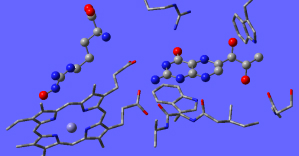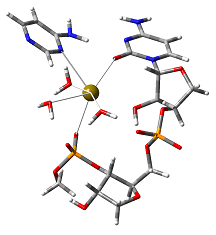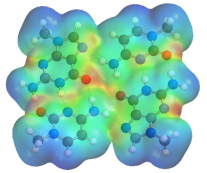Dr. James Gauld
Computational Chemistry
Ph.D (Australian National University)
gauld@uwindsor.ca
Associate Professor
253-3000 Ext. 3992
267 Essex Hall
Personal Website
RESEARCH INTERESTS:
Central to understanding the chemistry of cells is elucidating the chemistry of important biomolecules and their interactions. A class of biomolecules of particular interest is enzymes; molecules that catalyse the broad range of reactions essential for life. In addition to the fundamental knowledge to be learned, this interest is due in part to the medical and industrial benefits to be obtained. For example, the aim of therapeutic drugs is often to enhance or inhibit the function of a specific enzyme. Computational chemistry uses computers to model the chemistry and reactions of chemical systems. Such approaches are used, for example, to study problems that may be too difficult to study experimentally or to provide insight into observed phenomena. Our research group uses the methods of computational and theoretical chemistry to investigate the chemistry and reactions of various biomolecules, in particular biochemical catalysts. Brief overviews of some various areas studied by our group are described below.
PUBLICATIONS:
 The Chemistry of cofactors:
The Chemistry of cofactors:
Many enzymes require essential cofactors in order to perform their catalytic function. Such species often act as asource of functional groups or electrons. Their behaviour can differ between enzymes due to chemical variations in their binding sites which influence the structure and properties of the cofactor, tuning it to its role in the given enzyme. However, how such differences in the binding site affect the cofactors are often unknown. Modeling cofactor binding can thus provide greater insight into their roles in enzymes.
 Modeling active sites:
Modeling active sites:
Enzymes exploit cooperative effects of chemical interactions and environmental effects in order to catalyse reactions. In addition to investigating the actual catalytic mechanism, by modeling the structure of the active site one can study the role of individual enzyme-substrate interactions in the mechanism. Such studies not only provide deeper insight into how an enzyme actually functions, but also into, for example, what may be the consequences of a particular mutation. A focus of our research is the mechanisms and properties of ribo- and DNAzymes (catalytic nucleic acids) and novel protein metalloenzymes.
 DNA multiplexes:
DNA multiplexes:
During replication, single stranded DNA at the end of chromosomes are progressively shortened, thus regulating cell division. In cancer cells, however, certain enzymes are capable of repairing these ends, leading to immortality. It is thought that these single strands of DNA can form intra- or inter-strand complexes, leading to the formation of variously stacked multiplexes, thus making themselves unavailable to repair enzymes. As a result, there is considerable interest in developing therapeutic drugs that specifically bind such complexes. Hence, better understanding of the structure and properties of such multiplexes could lead to the development of new therapies.
SELECTED PUBLICATIONS:
- Dokainish, H.; Gauld, J.W.* (2013) An MD and QM/MM study on the Catalytic Reductase Mechanism of Methionine Sulfoxide Reductase A (MsrA): Formation and Reduction of a Sulfenic Acid. Biochemistry 52, 1814-1827.
- Bushnell, E.A.C.; Jamil, R.; Gauld, J.W.* (2013) Insights into the Chemistry of Lipoxygrnases (LOXs): A Computational Investigation Into The Catalytic Mechanism of 8R-LOX. J. Biol. Inorg. Chem. 18, 343-355.
- Bushnell, E.A.C.; Fortowsky, G.B.; Gauld, J.W.* (2012) Iron-Oxo Species and the Oxidation of Imidazole: Insights into the Mechanism of OvoA and EgtB. Inorg. Chem. 51, 13351–13356.
- Huang, W.J.; Gauld, J.W.* (2012) Tautomerization in the UDP-Galactopyranose Mutase Mechanism: A DFT-Cluster and QM/MM Investigation. J. Phys. Chem. B 116, 14040–14050.
- Ion, B.F.; Bushnell, E.A.C.; De Luna, P.; Gauld, J.W.* (2012) An MD and QM/MM Study on Ornithine Cyclodeaminase (OCD): A Tale of Two Iminiums. Int. J. Mol. Sci., 13, 12994-13011.
- Bushnell, E.A.C.; Gauld, J. W.* (2012) An Assessment of Standard, Hybrid, Meta and Hybrid-Meta GGA Density Functional Theory Methods for Open-Shell Systems: the Case of the Non-Heme Iron Enzyme 8R–LOX. J. Comput. Chem. 34, 141-128.
- Huang, W.J.; Gherib, R.; Gauld, J.W.* (2012) An Active Site Water Broadens Substrate Specificity in S-Ribosylhomocysteinase (LuxS): A Docking, MD, and QM/MM Study. J. Phys. Chem. B, 116, 8916-8929.
- Bushnell, E.A.C.; Huang, W.J.; Llano, J.; Gauld, J.W.* (2012) Molecular Dynamics Investigation into Substrate Binding and Identity of the Catalytic Base in the Mechanism of Threonyl-tRNA Synthetase. J. Phys. Chem. B, 116, 4205-5212.
- Almasi, J.; Bushnell, E.A.C.; Gauld, J.W.* (2011). A QM/MM-based Computational Investigation on the Catalytic Mechanism of Saccharopine Reductase. Molecules, 16, 8569-8589.

